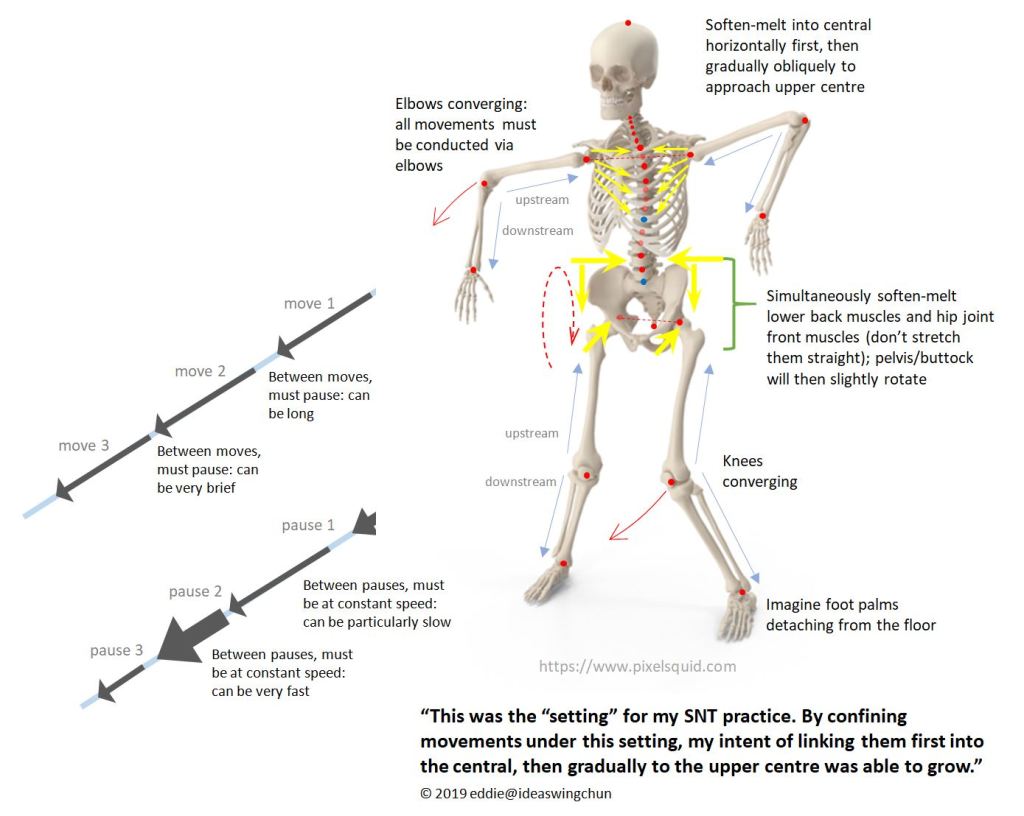
Kim Hoe: … Would you write a/multiple posts that explain about the proposed training flow for Siu Lim Tao from beginning till the end (integration of what you proposed in posts before, but no more mechanism, only focus on training)… Also, please share your experiences what you felt within your body/joint/part when you manage to unlock it.
Me: In this post I will describe what I had probably gone through when practising Siu Nim Tau. It is just “probably”, because it was not something systematic from the outset, but rather an exploratory process that could only be articulated in hindsight. As such, it is both personal and sketchy, not ready for generalising into rules to follow closely. Take it just as a reference from one of the many Wing Chun practitioners.
Start with the stance. At very early stage I put up a proper stance. But over time I just treated it as a kind of ordinary standing posture – feet separate in comfortable width, knees converging but not pronouncedly bent, pelvis/buttock not sitting – a normal standing but in the shape of the Wing Chun stance only.
Next is the spine. Make it rise by simultaneous intents: 1) Soften-melt from shoulders towards the central (horizontally first, then as obliquely as possible to approach the upper centre). 2) At the same time soften-melt the two large areas of muscles at the lower back, releasing and allowing the pelvis/buttock to rotate, slightly though, but do not push for the rotation. 3) Also soften-melt muscles in the front of the hip joints directly into the joints themselves. Sometimes it’s hard to imagine in this way. But in any case, avoid stretching those muscles straight as if your upper body can press through them directly onto the knees. This, on the contrary, will deactivate the hip joints and will easily result in pressing forward by leaning backward.
The simultaneous soften-melting at the lower back and the hip joints’ front jointly creates the rotating of the pelvis a bit forward (hence not sitting). To me, this is equivalent to Tai Gong. Now it’s ready to start SNT practice.
There are some “rules” on movements that I followed closely: 1) All movements must be conducted via the elbows, and the elbows are always converging. 2) There must be a pause, no matter how brief, between two consecutive movements. 3) A movement, which is itself between two consecutive pauses, should proceed at constant speed, i.e. no sudden impulse. While one movement can be very fast, another movement can be particularly slow. It applies to all movements including punching.
This was the “setting” for my SNT practice. By confining movements under this setting, my intent of linking them first into the central, then gradually to the upper centre was able to grow. This has been pretty much the way I worked on the entire form of SNT.
After some time, I was not satisfied with the extent of “dropping” (the term prevalent that time and probably nowadays too) at the shoulder areas. I decided to focus on improving it by just doing the first four movements of SNT – cutting downward, raising upward, and two punches – repeatedly. However, I did not intensify dropping. Rather, I used these few movements to trigger “some more rotation” directly in the shoulder joints (not the whole shoulders), yet maintaining the strong intent of soften-melting into the central and then the upper centre at every moment. In this period my practice was just on this four-movement SNT. It turned out to be fruitful! – by then my central (and then the upper centre) was able to reach the shoulder joints to empower the ligaments’ activity – that “some more rotation”. As a result, it was easier to skip the shoulders but have the central and the upper centre to directly deal with the incoming force at the forearms.
When the upper centre was able to link with the “more-rotated” shoulder joints (which further link to the elbows and forearms), I felt the rib cage, the head and the arms became one entity (let’s call it the rib cage entity). And the upper centre point was felt to behave like a switch – with a “click” there the rib cage entity could then immediately align with the vertebrae below, ready to take in power from the pelvis area.
As I have emphasised, there is no fixed sequence on which parts to explore. The above “setting” has provided me a good departure point for further exploring other body parts, whenever deemed necessary, by soften-melting (or dissolve-diffusing).
In my experience, it is both realistic and feasible to target to open up the upper body first (in the way described above) during the initial years of practising SNT. The lower body usually requires significantly more time to link through. At this stage, working on the pelvis area as described, treating the stance as a normal standing, plus imagining your foot palms wanting to detach from the floor, should be good enough for temporarily settling the lower body.
I’ll talk about how I found my lower body starting to link up in the upcoming posts.
2019.11.22